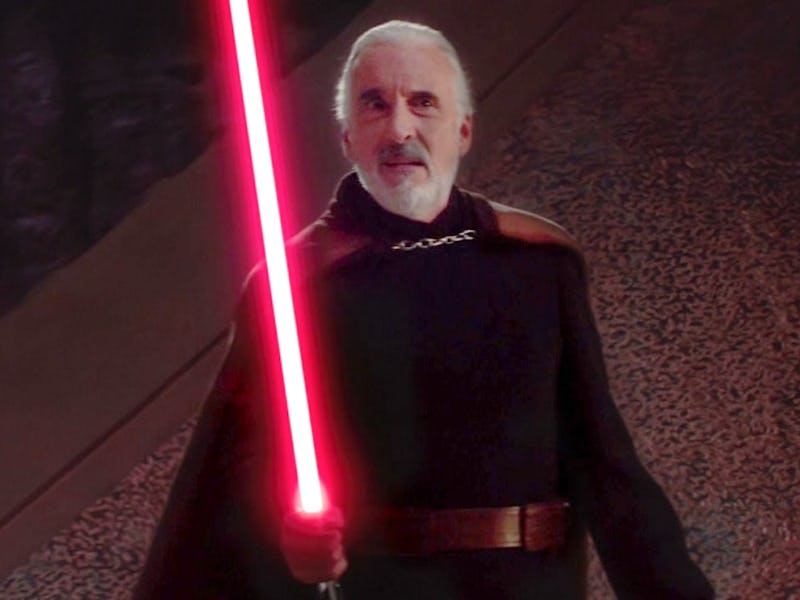20 years later, Star Wars just solved a Palpatine mystery from the prequels
When did Dooku become Palpatine’s apprentice? And why?

Why did Dooku turn to the Dark Side? Attack of the Clones begins with Count Dooku (Christopher Lee) already so clearly evil, so it’s easy to overlook how he got that way. And yet, because Dooku was once a Jedi and the master of Qui-Gon Jinn, he must have been good at some point.
The new animated anthology series Tales of the Jedi answers these questions and then some. In a shocking reveal, we not only understand why Dooku turned, but Tales of Jedi also gives us a missing piece between The Phantom Menace and Attack of the Clones.
Spoilers ahead for Tales of the Jedi.
Dooku’s slow slide to the Dark Side
Dooku and a very young Qui-Gon Jinn
As the second, third, and fourth episodes of Tales of the Jedi reveal, describing Dooku as a “political idealist” in Attack of the Clones is pretty accurate. What infuriates Dooku as a young Jedi Master is, essentially, that the Jedi are willing participants in various levels of corruption. In Episode 3, Dooku is frustrated by the fact that “Jedi claim peace, but mostly keep law and order for the rich and powerful.”
Because Episode 2 and Episode 3 specifically demonstrate this paradox, Dooku’s motivations for aligning himself with someone other than the Jedi order are almost a no-brainer. In a way, Dooku’s rationalization for working with Darth Sidious makes more sense than Maul’s apprenticeship or even Anakin turning to the Dark side.
With Maul and Vader, deep dark emotions are at play. But with Dooku, it’s this feeling of cold rationality combined with his ethics that pushes him toward his secret alliance. That is until the demise of Qui-Gon Jinn pushes him over the top.
How Qui-Gon changed everything
Dooku in 'The Tales of the Jedi.'
Tales of the Jedi Episode 4, “The Sith Lord,” takes place as a kind of series of deleted scenes from The Phantom Menace, but also as a quasi-flashback to Attack of the Clones. We open with Dooku removing data about the planet Kamino from the archive memory of the records in the Jedi Temple. At this point, even though Maul is still alive, Dooku isn’t technically a Sith apprentice, but rather, a willing participant in a complex conspiracy to unravel the Republic. But then, Qui-Gon Jinn (voiced by Liam Neeson) returns to Courscant to talk about his encounter with a Sith Lord on Tatooine.
Dooku obviously knows this is real. He’s aware that Darth Sidious is a Sith Lord and knows Darth Maul is out there doing the dirty work of Sidious. But once Dooku learns of Qui-Gon’s passing, he confronts Sidious saying, “You’ve gone too far.” Sidious tries to commiserate, by noting that they both lost an apprentice, but the twist comes when they realize Yaddle (Bryce Dallas Howard) has been spying on them. If Dooku wants to keep his conspiratorial activities a secret from the Jedi, he’ll have to murder Yaddle. In this moment, because he’s so mad about the passing of Qui-Gon Jinn, he blames the Jedi slightly more than he blames Sidious. This shift to the Dark Side is perhaps one of the most realistic turns we’ve ever seen in Star wars, and totally recontextualizes the slaying of Qui-Gon in a way we never imagined.
For years, Star Wars fans have loved to speculate about how Anakin’s future might have been altered had Qui-Gon lived. In essence, the argument goes that Qui-Gon’s passing indirectly created Darth Vader. But what’s been left out of this analysis is that Qui-Gon’s passing also directly created a different Sith Lord: Darth Tyrannus.
How Sidious played Dooku
Did Palpatine keep some of his secrets, even from Dooku?
“The Sith Lord” is brilliant because it deftly parallels the moment when Anakin turns to the Dark Side in Revenge of the Sith, but twists that tragedy in a few specific ways. In Revenge of the Sith, Palpatine used Anakin’s fear of losing Padmé to get Anakin to do whatever he wanted. With Dooku, he uses that political idealism again, saying to Dooku in a critical moment: “Remember what you told me. The Jedi blindly serve a corrupt Senate that fails the Republic it represents.” Because Dooku sees Yaddle as part of that corruption, it’s enough to push him over the top.
However, all this interestingly suggests another possible deception hiding in plain sight. This episode seems to lend credence to the slightly zany theory that Dooku may not know Palpatine and Sidious are the same person. Sidious seizes on Dooku’s political anger with the Republic and blends it with Dooku’s personal pain over the loss of Qui-Gon Jinn. This neatly allows him to replace Dooku as his new Sith apprentice. But “The Sith Lord” doesn’t end with Sidious saying, “Oh, by the way, I’ve got to catch a flight to Courscant to attend the funeral of Qui-Gon, because I’m really Palpatine.”
So, did Dooku ever really know Palpatine and Sidious were the same guy? It’s certainly possible he did. But everything we’ve learned about Dooku in Tales of the Jedi seems to suggest Palpatine was lying to Dooku even more than anyone ever realized before.